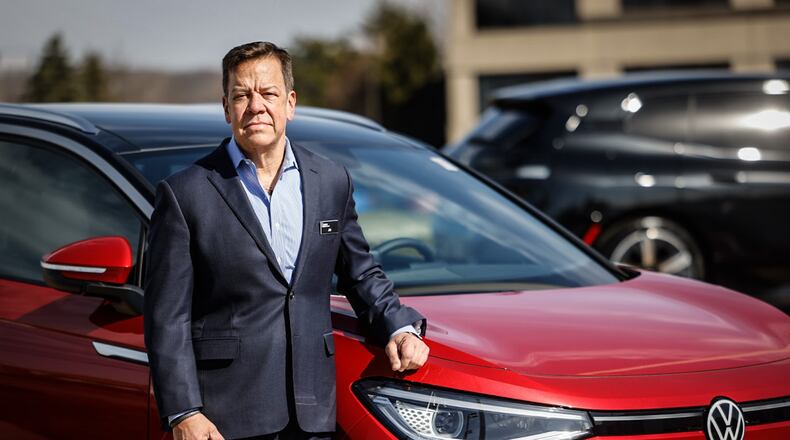But a variety of factors, including supply chain issues and demand exceeding supply, have made it challenging for some area residents to purchase them.
Ohio has not received as many electric vehicles as other areas because automakers are tending to put them where there’s either state-based incentives or the expressed desire for such vehicles, according to Marc Geller, spokesman for the Electric Vehicle Association, a more than 50-year-old volunteer nonprofit dedicated to promoting electric vehicles.
“Probably 40% or 50% of the electric cars in the United States have ended up in California, both because there were incentives and as well as a particular interest in electric cars for a long time,” Geller said.
But even as interest for electric vehicles rises across the nation, automakers aren’t making enough cars, he said.
“If people are scurrying around and trying to find a car, that means that demand exceeds supply,” he said. “I have been making the case actually for 20 years that the demand for electric cars exceeds supply and that I think is still the case.”
Geller points to a recent announcement by Ford touting that it had produced more than 53,000 electric vehicles, the second most in the United States. Meanwhile, Tesla in the United States sold between 300,000 and 400,000 vehicles among more than 1 million it sold worldwide, he said.
He said he is not surprised to hear that some motorists have difficulty finding electric vehicles. Ohio, like some other states, has “a legacy connection to the legacy automakers that have exercised their power to put roadblocks in the way of Tesla,” he said.
Drive Electric Dayton President Rap Hankins said the problem is that the legacy auto companies underestimated demand.
“They believed that people would not want electric vehicles the way they want them today,” he said. “They thought all they had to do was make fuel efficient petrol cars and it would satisfy people’s needs.”
Now companies are scrambling to catch up, building facilities stateside that will help them manufacture vehicles and batteries.
That includes BMW and Volkswagen, two brands carried by Evans Dealer Group, which started selling electric vehicles around 2015.
Back then electric vehicles were “like a boutique item,” said owner Jim Evans. While sales of EVs are “not yet fully mainstream” because of consumers’ hesitation over infrastructure in the range of their driving trips, it is “way more advanced than I thought it was going to be at this stage,” he said.
Evans predicts that between 20% to 25% of the BMWs he sells this year will be EVs, up from 3% in 2022, and 15% of the Volkswagens he sells will be EVs, up from 5% in 2022.
One thing slowing down production of EVs is a chip shortage, a situation that has improved from when it was at its worst last year but “is still lingering,” Hankins said.
Janice Williams, of Trotwood, said she test drove a Tesla in October 2020 and has rented several since then. She put in an order for a rear-wheel Tesla Model 3 on Feb. 17.
“There was no problem at all,” Williams said. “I just ordered it online, put my deposit down and I had it within a week, so my process was very simple.”
Helping consumers knock down the price of EVs are up to $7,500 in tax credits that are among a host of changes enacted in the Inflation Reduction Act, which Congress approved in August. The sweeping climate law is designed to spur EV sales as part of a broader effort to reduce greenhouse gas emissions.
Under the law, pickup trucks, SUVs and vans with a sticker price up to $80,000 qualify for EV tax credits, while new electric cars, sedans and wagons can only be priced up to $55,000.
But a complex web of requirements, including where vehicles and batteries must be manufactured to qualify, has cast doubt on whether buyers can receive the full $7,500 credit.
In addition, changes to the tax credits are expected to arrive sometime this month, but even Geller and Hankins said they aren’t clear on when they will occur and what exactly may be involved.
“It is, unfortunately, rather complex,” Geller said. He said PlugInAmerica.org offers free webinars to explain what changes might be in store.
Incentives are critical to getting more electric vehicles into the hands of the middle class, Hankins said.
“We find that wealthy people are buying cars that are good for the environment, that they’re buying cars that are fun, but we also think that it’s important that working class people are able to buy cars,” he said.
But now there are people buying electric vehicles in spite of the incentives.
“They want the cars so badly that if a car is off the lot, they will waive the incentive figure and buy the car anyway,” he said.
Now, automakers have gained a whole new perspective on the potential earning power of EVs, so production has launched on more models than ever, but “it takes time to get there.” Hankins said.
Reporting by the Associated Press was included in this report.
About the Author

